Adaptive Software Development Methodologies: Scrum and Extreme Programming
VerifiedAdded on 2023/06/07
|20
|3253
|377
AI Summary
This report discusses adaptive software development methodologies, their advantages and disadvantages, and two specific methodologies - Scrum and Extreme Programming. It also provides recommendations on which methodology is best for implementing a new information system for Odd Jobs Limited.
Contribute Materials
Your contribution can guide someone’s learning journey. Share your
documents today.

i
Name
Institution
Course
Instructor
Name
Institution
Course
Instructor
Secure Best Marks with AI Grader
Need help grading? Try our AI Grader for instant feedback on your assignments.
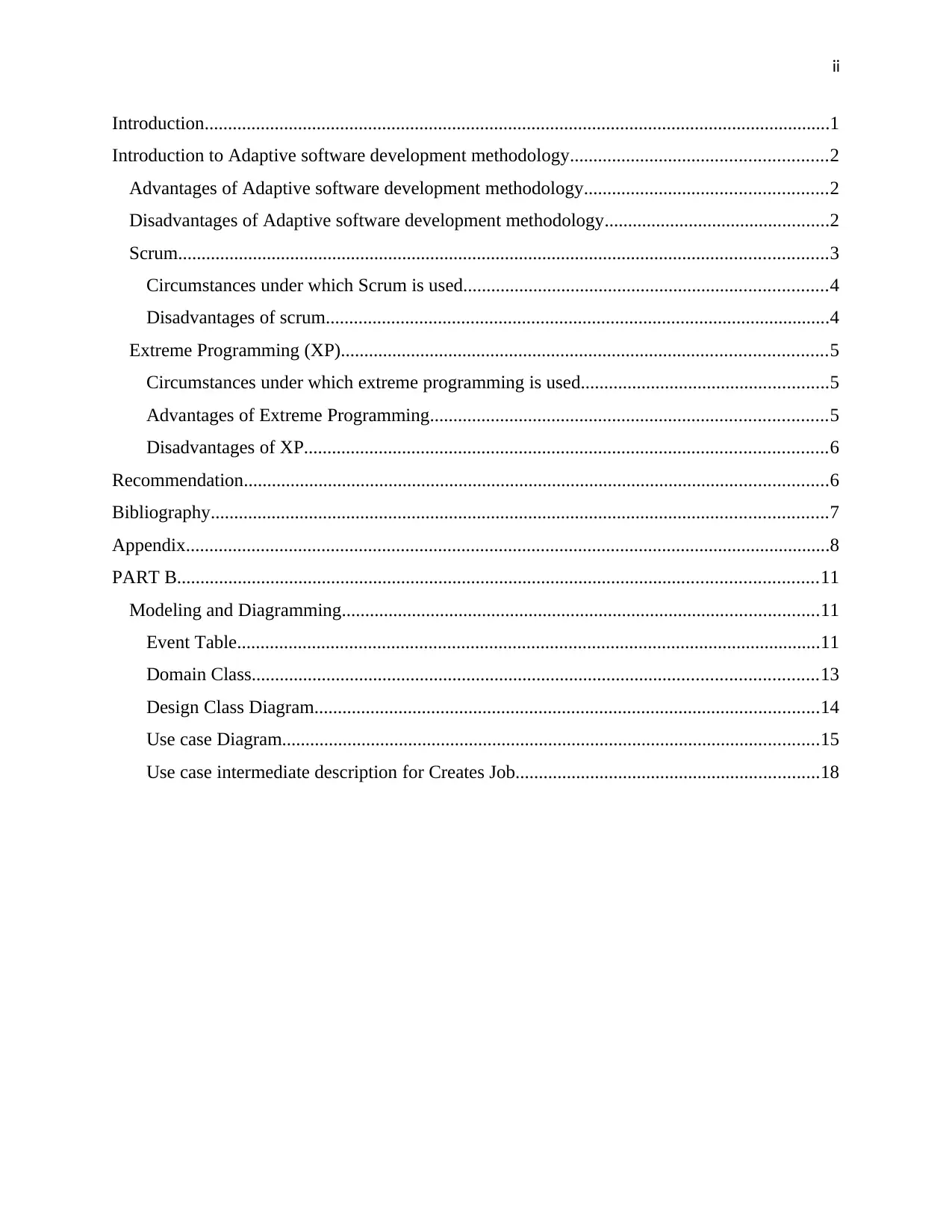
ii
Introduction......................................................................................................................................1
Introduction to Adaptive software development methodology.......................................................2
Advantages of Adaptive software development methodology....................................................2
Disadvantages of Adaptive software development methodology................................................2
Scrum...........................................................................................................................................3
Circumstances under which Scrum is used..............................................................................4
Disadvantages of scrum............................................................................................................4
Extreme Programming (XP)........................................................................................................5
Circumstances under which extreme programming is used.....................................................5
Advantages of Extreme Programming.....................................................................................5
Disadvantages of XP................................................................................................................6
Recommendation.............................................................................................................................6
Bibliography....................................................................................................................................7
Appendix..........................................................................................................................................8
PART B.........................................................................................................................................11
Modeling and Diagramming......................................................................................................11
Event Table.............................................................................................................................11
Domain Class.........................................................................................................................13
Design Class Diagram............................................................................................................14
Use case Diagram...................................................................................................................15
Use case intermediate description for Creates Job.................................................................18
Introduction......................................................................................................................................1
Introduction to Adaptive software development methodology.......................................................2
Advantages of Adaptive software development methodology....................................................2
Disadvantages of Adaptive software development methodology................................................2
Scrum...........................................................................................................................................3
Circumstances under which Scrum is used..............................................................................4
Disadvantages of scrum............................................................................................................4
Extreme Programming (XP)........................................................................................................5
Circumstances under which extreme programming is used.....................................................5
Advantages of Extreme Programming.....................................................................................5
Disadvantages of XP................................................................................................................6
Recommendation.............................................................................................................................6
Bibliography....................................................................................................................................7
Appendix..........................................................................................................................................8
PART B.........................................................................................................................................11
Modeling and Diagramming......................................................................................................11
Event Table.............................................................................................................................11
Domain Class.........................................................................................................................13
Design Class Diagram............................................................................................................14
Use case Diagram...................................................................................................................15
Use case intermediate description for Creates Job.................................................................18
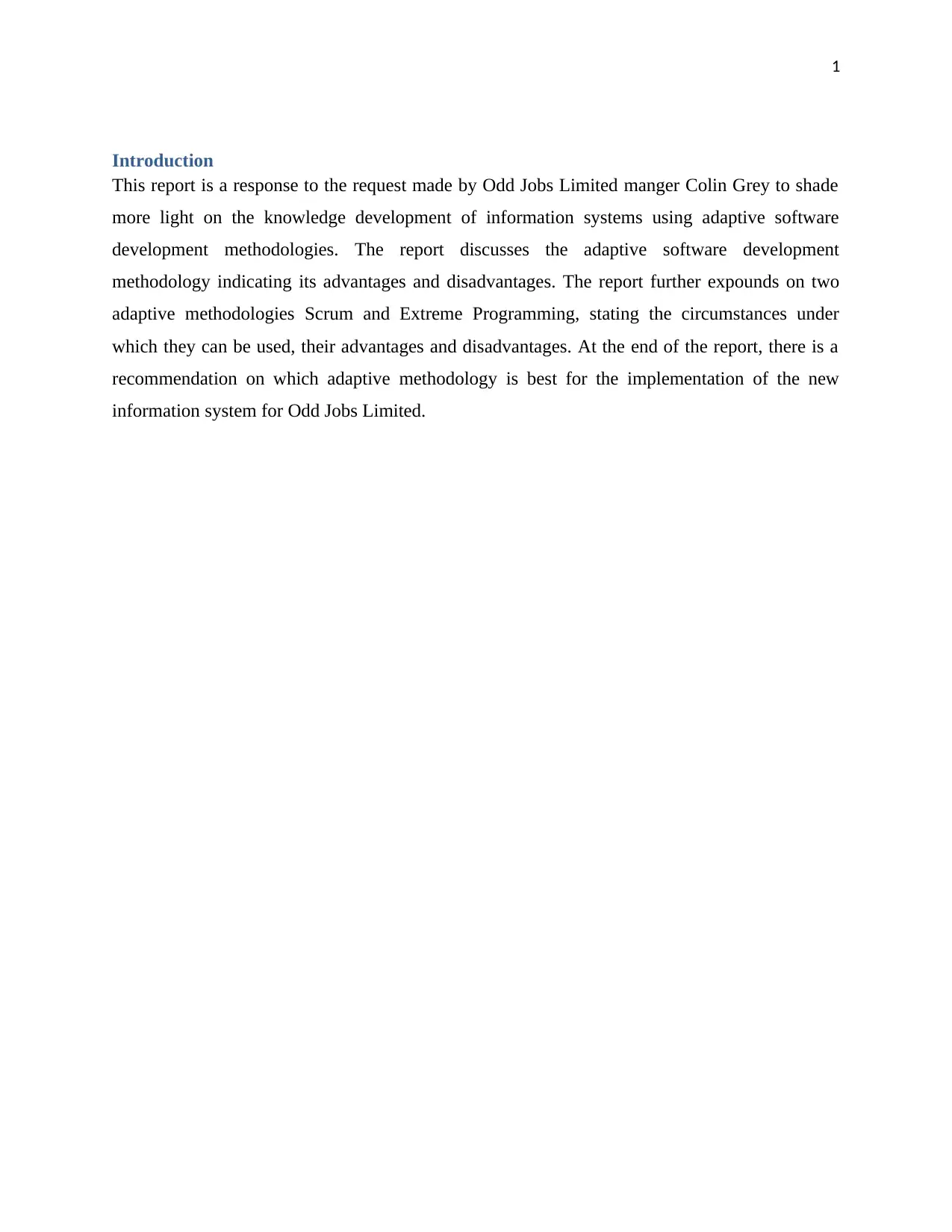
1
Introduction
This report is a response to the request made by Odd Jobs Limited manger Colin Grey to shade
more light on the knowledge development of information systems using adaptive software
development methodologies. The report discusses the adaptive software development
methodology indicating its advantages and disadvantages. The report further expounds on two
adaptive methodologies Scrum and Extreme Programming, stating the circumstances under
which they can be used, their advantages and disadvantages. At the end of the report, there is a
recommendation on which adaptive methodology is best for the implementation of the new
information system for Odd Jobs Limited.
Introduction
This report is a response to the request made by Odd Jobs Limited manger Colin Grey to shade
more light on the knowledge development of information systems using adaptive software
development methodologies. The report discusses the adaptive software development
methodology indicating its advantages and disadvantages. The report further expounds on two
adaptive methodologies Scrum and Extreme Programming, stating the circumstances under
which they can be used, their advantages and disadvantages. At the end of the report, there is a
recommendation on which adaptive methodology is best for the implementation of the new
information system for Odd Jobs Limited.
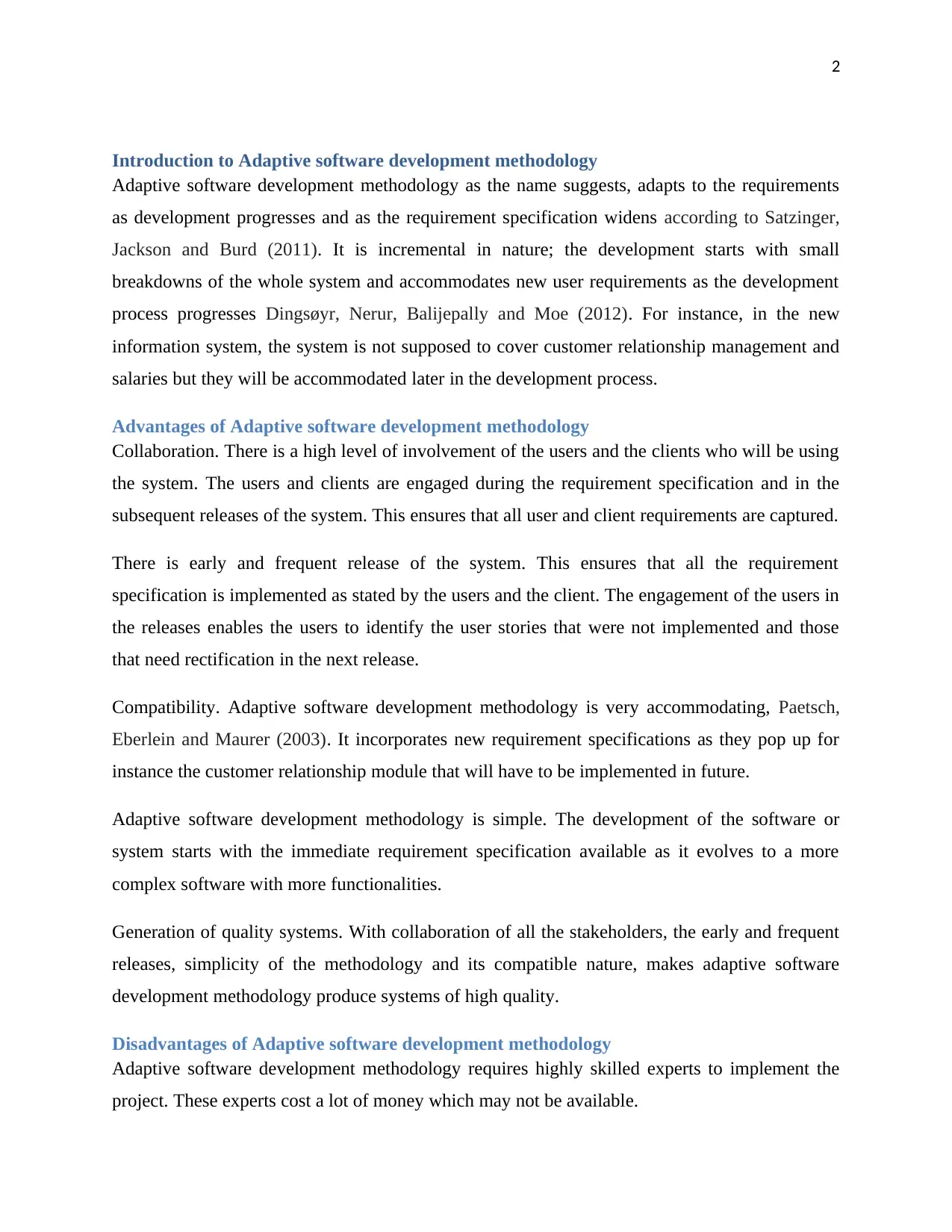
2
Introduction to Adaptive software development methodology
Adaptive software development methodology as the name suggests, adapts to the requirements
as development progresses and as the requirement specification widens according to Satzinger,
Jackson and Burd (2011). It is incremental in nature; the development starts with small
breakdowns of the whole system and accommodates new user requirements as the development
process progresses Dingsøyr, Nerur, Balijepally and Moe (2012). For instance, in the new
information system, the system is not supposed to cover customer relationship management and
salaries but they will be accommodated later in the development process.
Advantages of Adaptive software development methodology
Collaboration. There is a high level of involvement of the users and the clients who will be using
the system. The users and clients are engaged during the requirement specification and in the
subsequent releases of the system. This ensures that all user and client requirements are captured.
There is early and frequent release of the system. This ensures that all the requirement
specification is implemented as stated by the users and the client. The engagement of the users in
the releases enables the users to identify the user stories that were not implemented and those
that need rectification in the next release.
Compatibility. Adaptive software development methodology is very accommodating, Paetsch,
Eberlein and Maurer (2003). It incorporates new requirement specifications as they pop up for
instance the customer relationship module that will have to be implemented in future.
Adaptive software development methodology is simple. The development of the software or
system starts with the immediate requirement specification available as it evolves to a more
complex software with more functionalities.
Generation of quality systems. With collaboration of all the stakeholders, the early and frequent
releases, simplicity of the methodology and its compatible nature, makes adaptive software
development methodology produce systems of high quality.
Disadvantages of Adaptive software development methodology
Adaptive software development methodology requires highly skilled experts to implement the
project. These experts cost a lot of money which may not be available.
Introduction to Adaptive software development methodology
Adaptive software development methodology as the name suggests, adapts to the requirements
as development progresses and as the requirement specification widens according to Satzinger,
Jackson and Burd (2011). It is incremental in nature; the development starts with small
breakdowns of the whole system and accommodates new user requirements as the development
process progresses Dingsøyr, Nerur, Balijepally and Moe (2012). For instance, in the new
information system, the system is not supposed to cover customer relationship management and
salaries but they will be accommodated later in the development process.
Advantages of Adaptive software development methodology
Collaboration. There is a high level of involvement of the users and the clients who will be using
the system. The users and clients are engaged during the requirement specification and in the
subsequent releases of the system. This ensures that all user and client requirements are captured.
There is early and frequent release of the system. This ensures that all the requirement
specification is implemented as stated by the users and the client. The engagement of the users in
the releases enables the users to identify the user stories that were not implemented and those
that need rectification in the next release.
Compatibility. Adaptive software development methodology is very accommodating, Paetsch,
Eberlein and Maurer (2003). It incorporates new requirement specifications as they pop up for
instance the customer relationship module that will have to be implemented in future.
Adaptive software development methodology is simple. The development of the software or
system starts with the immediate requirement specification available as it evolves to a more
complex software with more functionalities.
Generation of quality systems. With collaboration of all the stakeholders, the early and frequent
releases, simplicity of the methodology and its compatible nature, makes adaptive software
development methodology produce systems of high quality.
Disadvantages of Adaptive software development methodology
Adaptive software development methodology requires highly skilled experts to implement the
project. These experts cost a lot of money which may not be available.
Secure Best Marks with AI Grader
Need help grading? Try our AI Grader for instant feedback on your assignments.
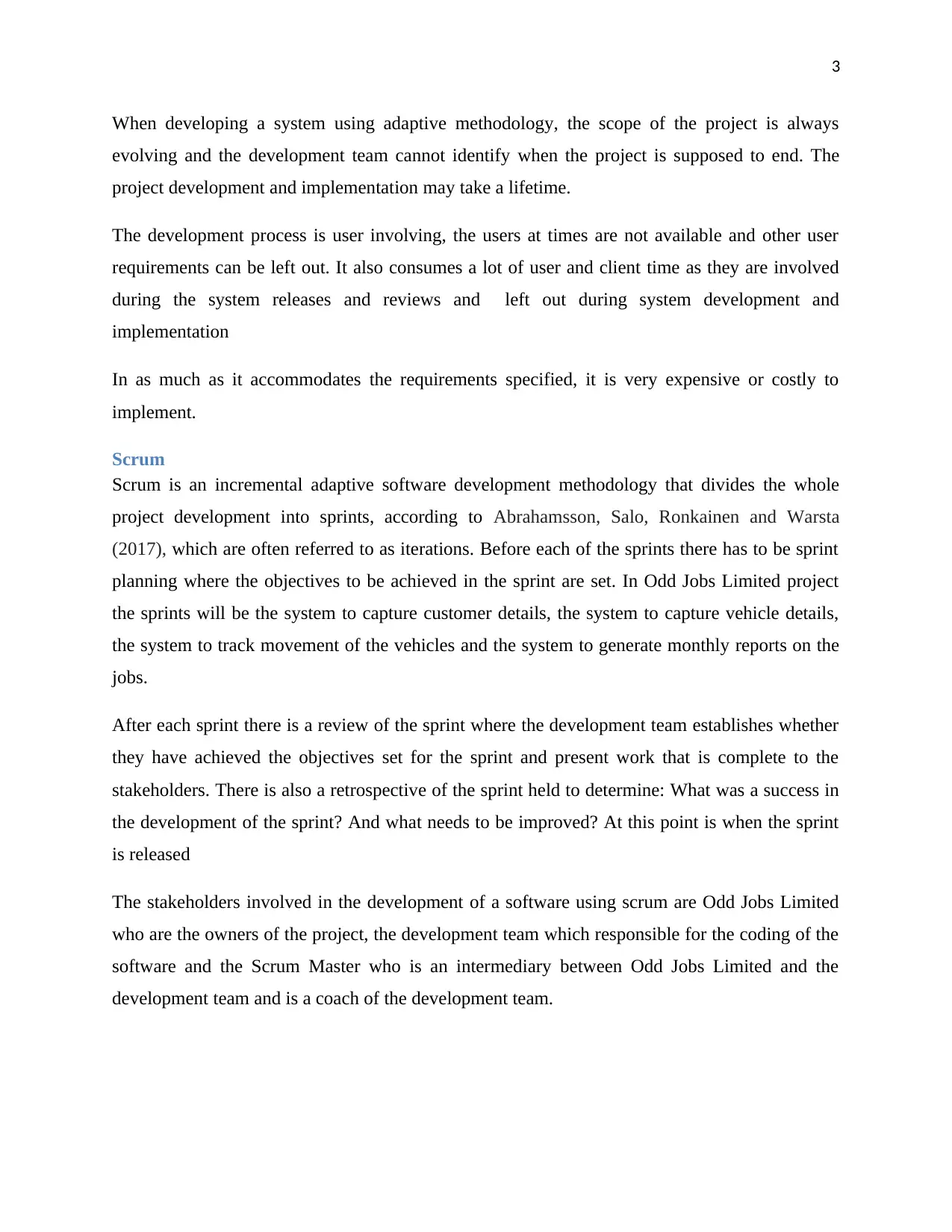
3
When developing a system using adaptive methodology, the scope of the project is always
evolving and the development team cannot identify when the project is supposed to end. The
project development and implementation may take a lifetime.
The development process is user involving, the users at times are not available and other user
requirements can be left out. It also consumes a lot of user and client time as they are involved
during the system releases and reviews and left out during system development and
implementation
In as much as it accommodates the requirements specified, it is very expensive or costly to
implement.
Scrum
Scrum is an incremental adaptive software development methodology that divides the whole
project development into sprints, according to Abrahamsson, Salo, Ronkainen and Warsta
(2017), which are often referred to as iterations. Before each of the sprints there has to be sprint
planning where the objectives to be achieved in the sprint are set. In Odd Jobs Limited project
the sprints will be the system to capture customer details, the system to capture vehicle details,
the system to track movement of the vehicles and the system to generate monthly reports on the
jobs.
After each sprint there is a review of the sprint where the development team establishes whether
they have achieved the objectives set for the sprint and present work that is complete to the
stakeholders. There is also a retrospective of the sprint held to determine: What was a success in
the development of the sprint? And what needs to be improved? At this point is when the sprint
is released
The stakeholders involved in the development of a software using scrum are Odd Jobs Limited
who are the owners of the project, the development team which responsible for the coding of the
software and the Scrum Master who is an intermediary between Odd Jobs Limited and the
development team and is a coach of the development team.
When developing a system using adaptive methodology, the scope of the project is always
evolving and the development team cannot identify when the project is supposed to end. The
project development and implementation may take a lifetime.
The development process is user involving, the users at times are not available and other user
requirements can be left out. It also consumes a lot of user and client time as they are involved
during the system releases and reviews and left out during system development and
implementation
In as much as it accommodates the requirements specified, it is very expensive or costly to
implement.
Scrum
Scrum is an incremental adaptive software development methodology that divides the whole
project development into sprints, according to Abrahamsson, Salo, Ronkainen and Warsta
(2017), which are often referred to as iterations. Before each of the sprints there has to be sprint
planning where the objectives to be achieved in the sprint are set. In Odd Jobs Limited project
the sprints will be the system to capture customer details, the system to capture vehicle details,
the system to track movement of the vehicles and the system to generate monthly reports on the
jobs.
After each sprint there is a review of the sprint where the development team establishes whether
they have achieved the objectives set for the sprint and present work that is complete to the
stakeholders. There is also a retrospective of the sprint held to determine: What was a success in
the development of the sprint? And what needs to be improved? At this point is when the sprint
is released
The stakeholders involved in the development of a software using scrum are Odd Jobs Limited
who are the owners of the project, the development team which responsible for the coding of the
software and the Scrum Master who is an intermediary between Odd Jobs Limited and the
development team and is a coach of the development team.
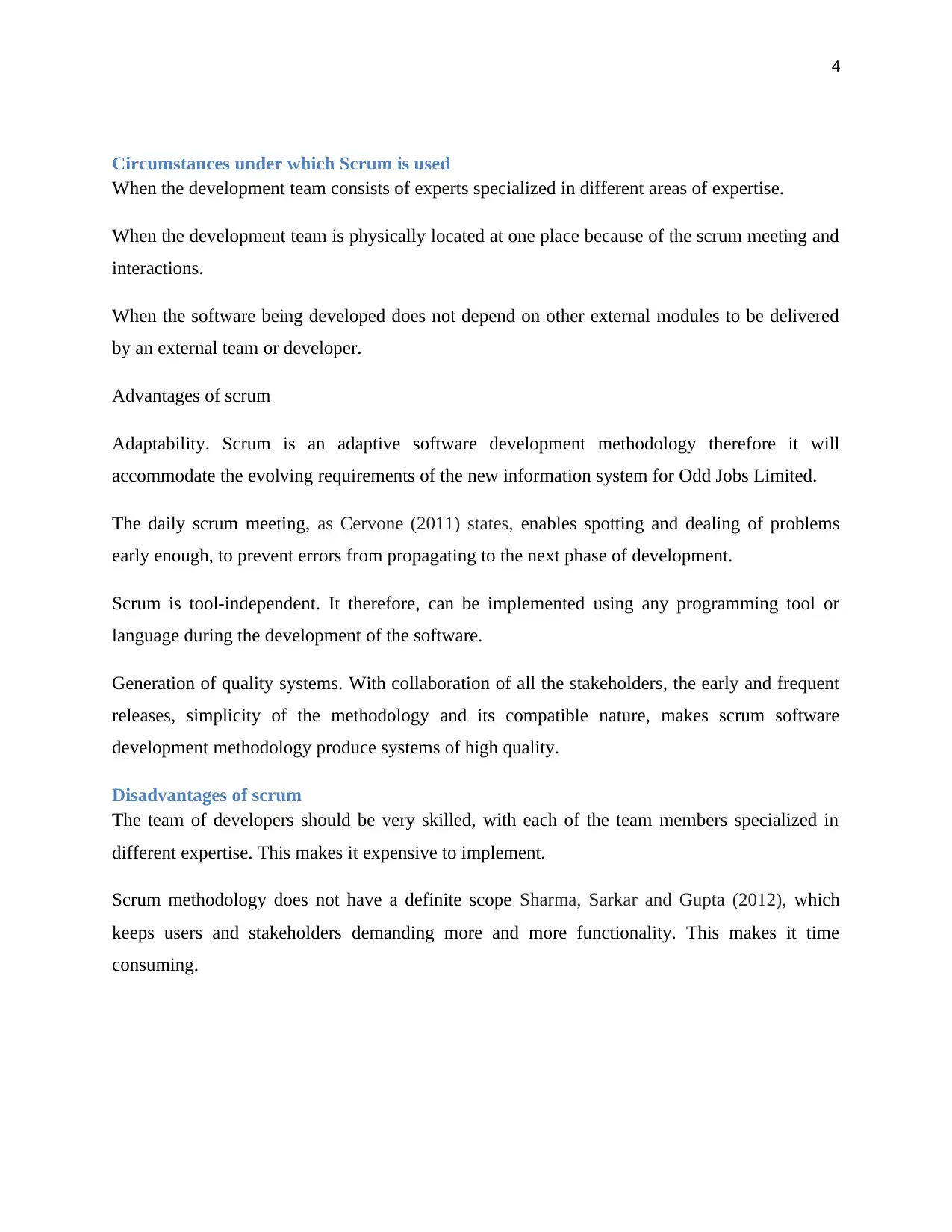
4
Circumstances under which Scrum is used
When the development team consists of experts specialized in different areas of expertise.
When the development team is physically located at one place because of the scrum meeting and
interactions.
When the software being developed does not depend on other external modules to be delivered
by an external team or developer.
Advantages of scrum
Adaptability. Scrum is an adaptive software development methodology therefore it will
accommodate the evolving requirements of the new information system for Odd Jobs Limited.
The daily scrum meeting, as Cervone (2011) states, enables spotting and dealing of problems
early enough, to prevent errors from propagating to the next phase of development.
Scrum is tool-independent. It therefore, can be implemented using any programming tool or
language during the development of the software.
Generation of quality systems. With collaboration of all the stakeholders, the early and frequent
releases, simplicity of the methodology and its compatible nature, makes scrum software
development methodology produce systems of high quality.
Disadvantages of scrum
The team of developers should be very skilled, with each of the team members specialized in
different expertise. This makes it expensive to implement.
Scrum methodology does not have a definite scope Sharma, Sarkar and Gupta (2012), which
keeps users and stakeholders demanding more and more functionality. This makes it time
consuming.
Circumstances under which Scrum is used
When the development team consists of experts specialized in different areas of expertise.
When the development team is physically located at one place because of the scrum meeting and
interactions.
When the software being developed does not depend on other external modules to be delivered
by an external team or developer.
Advantages of scrum
Adaptability. Scrum is an adaptive software development methodology therefore it will
accommodate the evolving requirements of the new information system for Odd Jobs Limited.
The daily scrum meeting, as Cervone (2011) states, enables spotting and dealing of problems
early enough, to prevent errors from propagating to the next phase of development.
Scrum is tool-independent. It therefore, can be implemented using any programming tool or
language during the development of the software.
Generation of quality systems. With collaboration of all the stakeholders, the early and frequent
releases, simplicity of the methodology and its compatible nature, makes scrum software
development methodology produce systems of high quality.
Disadvantages of scrum
The team of developers should be very skilled, with each of the team members specialized in
different expertise. This makes it expensive to implement.
Scrum methodology does not have a definite scope Sharma, Sarkar and Gupta (2012), which
keeps users and stakeholders demanding more and more functionality. This makes it time
consuming.
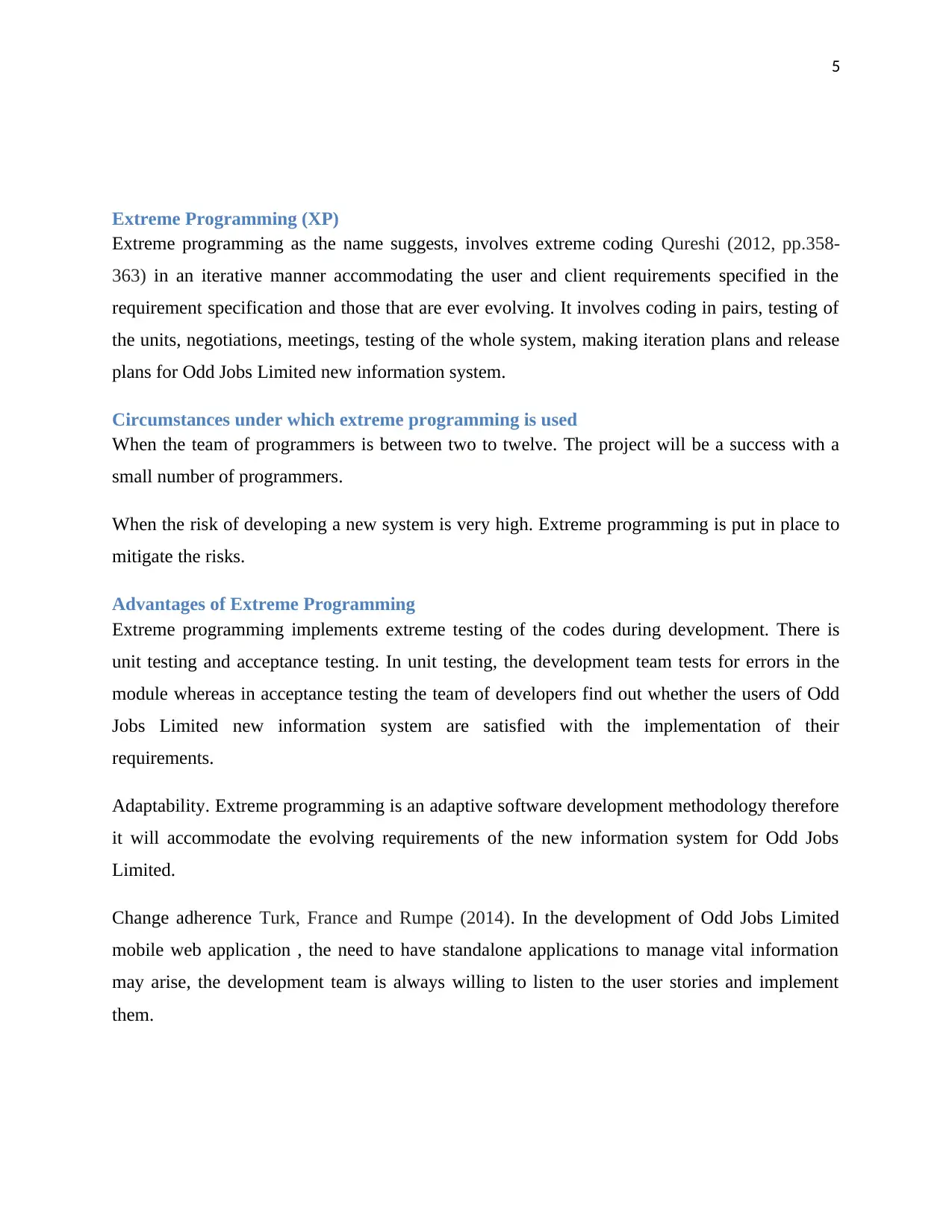
5
Extreme Programming (XP)
Extreme programming as the name suggests, involves extreme coding Qureshi (2012, pp.358-
363) in an iterative manner accommodating the user and client requirements specified in the
requirement specification and those that are ever evolving. It involves coding in pairs, testing of
the units, negotiations, meetings, testing of the whole system, making iteration plans and release
plans for Odd Jobs Limited new information system.
Circumstances under which extreme programming is used
When the team of programmers is between two to twelve. The project will be a success with a
small number of programmers.
When the risk of developing a new system is very high. Extreme programming is put in place to
mitigate the risks.
Advantages of Extreme Programming
Extreme programming implements extreme testing of the codes during development. There is
unit testing and acceptance testing. In unit testing, the development team tests for errors in the
module whereas in acceptance testing the team of developers find out whether the users of Odd
Jobs Limited new information system are satisfied with the implementation of their
requirements.
Adaptability. Extreme programming is an adaptive software development methodology therefore
it will accommodate the evolving requirements of the new information system for Odd Jobs
Limited.
Change adherence Turk, France and Rumpe (2014). In the development of Odd Jobs Limited
mobile web application , the need to have standalone applications to manage vital information
may arise, the development team is always willing to listen to the user stories and implement
them.
Extreme Programming (XP)
Extreme programming as the name suggests, involves extreme coding Qureshi (2012, pp.358-
363) in an iterative manner accommodating the user and client requirements specified in the
requirement specification and those that are ever evolving. It involves coding in pairs, testing of
the units, negotiations, meetings, testing of the whole system, making iteration plans and release
plans for Odd Jobs Limited new information system.
Circumstances under which extreme programming is used
When the team of programmers is between two to twelve. The project will be a success with a
small number of programmers.
When the risk of developing a new system is very high. Extreme programming is put in place to
mitigate the risks.
Advantages of Extreme Programming
Extreme programming implements extreme testing of the codes during development. There is
unit testing and acceptance testing. In unit testing, the development team tests for errors in the
module whereas in acceptance testing the team of developers find out whether the users of Odd
Jobs Limited new information system are satisfied with the implementation of their
requirements.
Adaptability. Extreme programming is an adaptive software development methodology therefore
it will accommodate the evolving requirements of the new information system for Odd Jobs
Limited.
Change adherence Turk, France and Rumpe (2014). In the development of Odd Jobs Limited
mobile web application , the need to have standalone applications to manage vital information
may arise, the development team is always willing to listen to the user stories and implement
them.
Paraphrase This Document
Need a fresh take? Get an instant paraphrase of this document with our AI Paraphraser

6
Disadvantages of XP
There will be no design and documentation Turk, France and Rumpe (2014) of the requirements
of the new mobile web application for Odd Jobs Limited.
Extreme programming requires a team of very skilled system developers, according to Fruhling
and Vreede (2006), to implement the new mobile web application for Odd Jobs Limited
Recommendation
Odd Jobs Limited management should choose Extreme Programming adaptive software
development methodology to implement the new mobile web application. This is because XP
involves extreme programming and testing that ensures no errors propagate and produce high
quality software. Scrum on the other hand, has so many restrictions it cannot be used when a
team of developers are separated geographically. XP can be implemented with the team of
developers being physically separated.
Disadvantages of XP
There will be no design and documentation Turk, France and Rumpe (2014) of the requirements
of the new mobile web application for Odd Jobs Limited.
Extreme programming requires a team of very skilled system developers, according to Fruhling
and Vreede (2006), to implement the new mobile web application for Odd Jobs Limited
Recommendation
Odd Jobs Limited management should choose Extreme Programming adaptive software
development methodology to implement the new mobile web application. This is because XP
involves extreme programming and testing that ensures no errors propagate and produce high
quality software. Scrum on the other hand, has so many restrictions it cannot be used when a
team of developers are separated geographically. XP can be implemented with the team of
developers being physically separated.

7
Bibliography
Abrahamsson, P., Salo, O., Ronkainen, J. and Warsta, J., (2017). Agile software development
methods: Review and analysis. arXiv preprint arXiv:1709.08439.
Cervone, H.F., (2011). Understanding agile project management methods using Scrum. OCLC
Systems & Services: International digital library perspectives, 27(1), pp.18-22.
Dingsøyr, T., Nerur, S., Balijepally, V. and Moe, N.B., (2012). A decade of agile methodologies:
Towards explaining agile software development. Systems and Software. [online] Volume 85,
Issue 6, June 2012, pp.1222-1238. Available from:
https://www.sciencedirect.com/science/article/pii/S0164121212000532 [Accessed 24 September
2018].
Fruhling, A. and Vreede, G.J.D., (2006). Field experiences with eXtreme programming:
developing an emergency response system. Journal of Management Information Systems, 22(4),
pp.39-68.
Paetsch, F., Eberlein, A. and Maurer, F., (2003), June. Requirements engineering and agile
software development. In Enabling Technologies: Infrastructure for Collaborative Enterprises,
2003. WET ICE 2003. Proceedings. Twelfth IEEE International Workshops on (pp. 308-313).
IEEE.
Qureshi, M.R.J., (2012). Agile software development methodology for medium and large
projects. IET software, 6(4), pp.358-363.
Satzinger, J.W., Jackson, R.B. and Burd, S.D., (2011). Systems analysis and design in a
changing world [online]. 1st November 2011. Cengage Learning. Pp.244. Available from:
https://books.google.co.ke/books?
hl=en&lr=&id=eRQKAAAAQBAJ&oi=fnd&pg=PR3&dq=Satzinger,+J.W.,+Jackson,+R.B.
+and+Burd,+S.D.,
+2011&ots=ssBzwMrmqW&sig=V8oDy2zbDpXzTdySmbkB565nmsw&redir_esc=y#v=onepage
&q&f=false [Accessed 24 September 2018]
Sharma, S., Sarkar, D. and Gupta, D., (2012). Agile processes and methodologies: A conceptual
study. International journal on computer science and Engineering, 4(5), p.892.
Bibliography
Abrahamsson, P., Salo, O., Ronkainen, J. and Warsta, J., (2017). Agile software development
methods: Review and analysis. arXiv preprint arXiv:1709.08439.
Cervone, H.F., (2011). Understanding agile project management methods using Scrum. OCLC
Systems & Services: International digital library perspectives, 27(1), pp.18-22.
Dingsøyr, T., Nerur, S., Balijepally, V. and Moe, N.B., (2012). A decade of agile methodologies:
Towards explaining agile software development. Systems and Software. [online] Volume 85,
Issue 6, June 2012, pp.1222-1238. Available from:
https://www.sciencedirect.com/science/article/pii/S0164121212000532 [Accessed 24 September
2018].
Fruhling, A. and Vreede, G.J.D., (2006). Field experiences with eXtreme programming:
developing an emergency response system. Journal of Management Information Systems, 22(4),
pp.39-68.
Paetsch, F., Eberlein, A. and Maurer, F., (2003), June. Requirements engineering and agile
software development. In Enabling Technologies: Infrastructure for Collaborative Enterprises,
2003. WET ICE 2003. Proceedings. Twelfth IEEE International Workshops on (pp. 308-313).
IEEE.
Qureshi, M.R.J., (2012). Agile software development methodology for medium and large
projects. IET software, 6(4), pp.358-363.
Satzinger, J.W., Jackson, R.B. and Burd, S.D., (2011). Systems analysis and design in a
changing world [online]. 1st November 2011. Cengage Learning. Pp.244. Available from:
https://books.google.co.ke/books?
hl=en&lr=&id=eRQKAAAAQBAJ&oi=fnd&pg=PR3&dq=Satzinger,+J.W.,+Jackson,+R.B.
+and+Burd,+S.D.,
+2011&ots=ssBzwMrmqW&sig=V8oDy2zbDpXzTdySmbkB565nmsw&redir_esc=y#v=onepage
&q&f=false [Accessed 24 September 2018]
Sharma, S., Sarkar, D. and Gupta, D., (2012). Agile processes and methodologies: A conceptual
study. International journal on computer science and Engineering, 4(5), p.892.
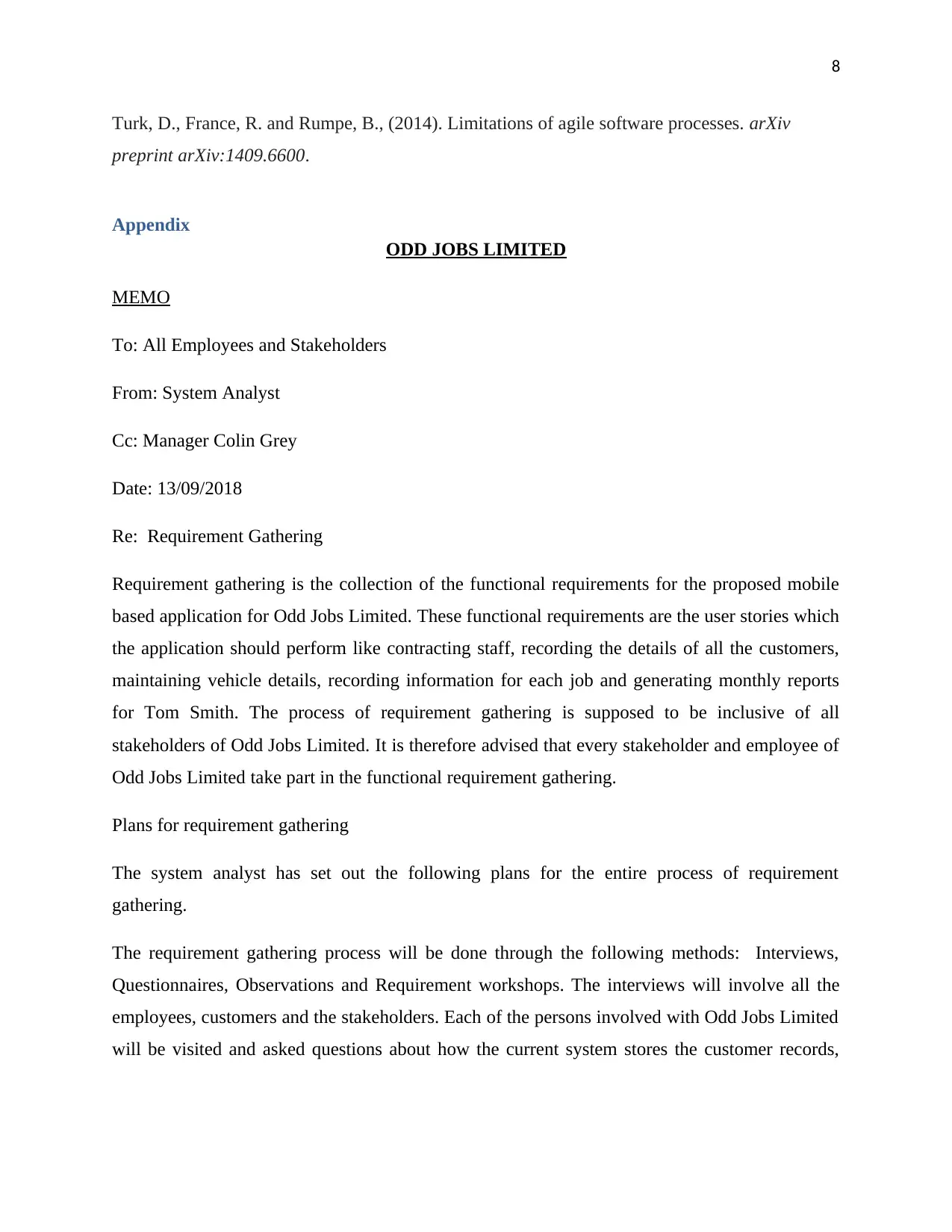
8
Turk, D., France, R. and Rumpe, B., (2014). Limitations of agile software processes. arXiv
preprint arXiv:1409.6600.
Appendix
ODD JOBS LIMITED
MEMO
To: All Employees and Stakeholders
From: System Analyst
Cc: Manager Colin Grey
Date: 13/09/2018
Re: Requirement Gathering
Requirement gathering is the collection of the functional requirements for the proposed mobile
based application for Odd Jobs Limited. These functional requirements are the user stories which
the application should perform like contracting staff, recording the details of all the customers,
maintaining vehicle details, recording information for each job and generating monthly reports
for Tom Smith. The process of requirement gathering is supposed to be inclusive of all
stakeholders of Odd Jobs Limited. It is therefore advised that every stakeholder and employee of
Odd Jobs Limited take part in the functional requirement gathering.
Plans for requirement gathering
The system analyst has set out the following plans for the entire process of requirement
gathering.
The requirement gathering process will be done through the following methods: Interviews,
Questionnaires, Observations and Requirement workshops. The interviews will involve all the
employees, customers and the stakeholders. Each of the persons involved with Odd Jobs Limited
will be visited and asked questions about how the current system stores the customer records,
Turk, D., France, R. and Rumpe, B., (2014). Limitations of agile software processes. arXiv
preprint arXiv:1409.6600.
Appendix
ODD JOBS LIMITED
MEMO
To: All Employees and Stakeholders
From: System Analyst
Cc: Manager Colin Grey
Date: 13/09/2018
Re: Requirement Gathering
Requirement gathering is the collection of the functional requirements for the proposed mobile
based application for Odd Jobs Limited. These functional requirements are the user stories which
the application should perform like contracting staff, recording the details of all the customers,
maintaining vehicle details, recording information for each job and generating monthly reports
for Tom Smith. The process of requirement gathering is supposed to be inclusive of all
stakeholders of Odd Jobs Limited. It is therefore advised that every stakeholder and employee of
Odd Jobs Limited take part in the functional requirement gathering.
Plans for requirement gathering
The system analyst has set out the following plans for the entire process of requirement
gathering.
The requirement gathering process will be done through the following methods: Interviews,
Questionnaires, Observations and Requirement workshops. The interviews will involve all the
employees, customers and the stakeholders. Each of the persons involved with Odd Jobs Limited
will be visited and asked questions about how the current system stores the customer records,
Secure Best Marks with AI Grader
Need help grading? Try our AI Grader for instant feedback on your assignments.
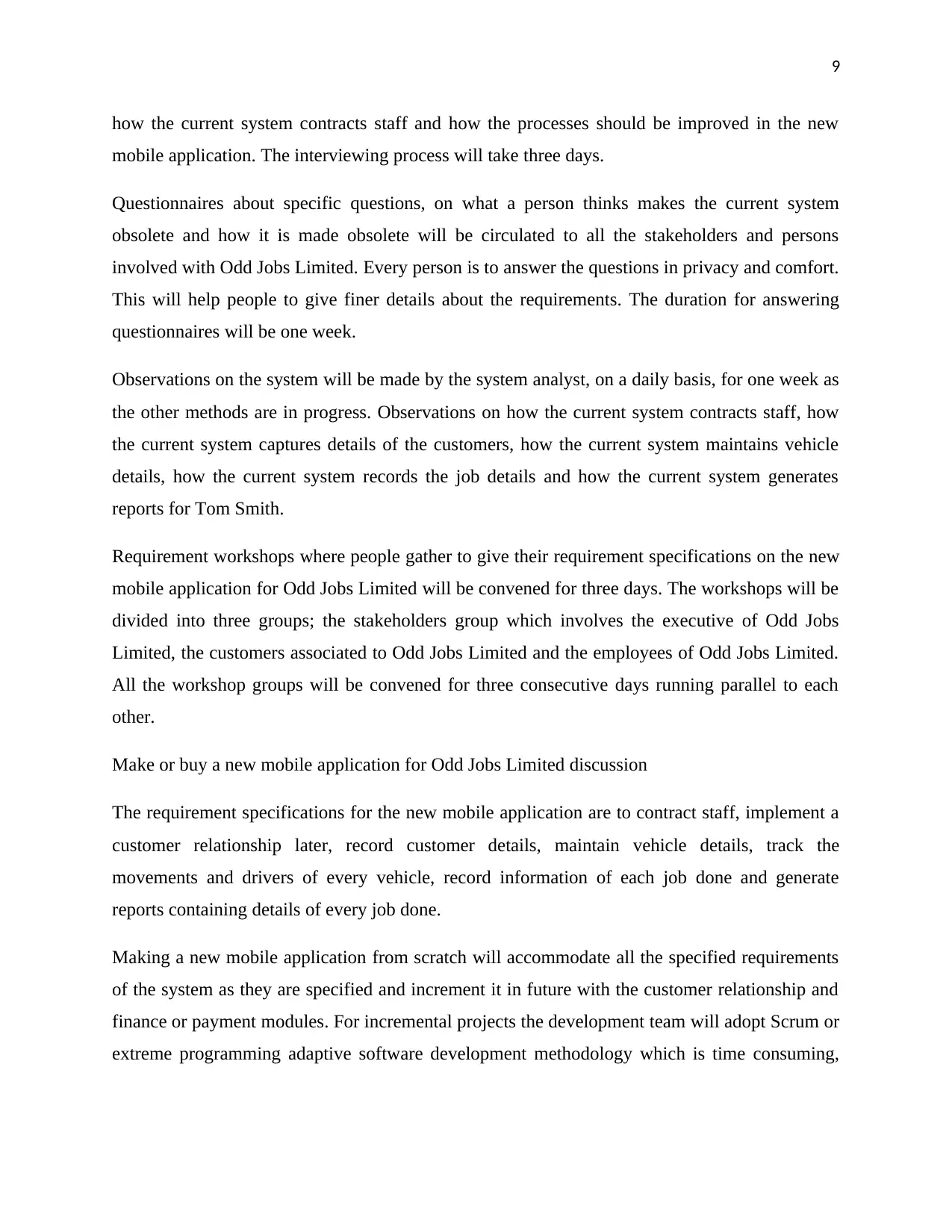
9
how the current system contracts staff and how the processes should be improved in the new
mobile application. The interviewing process will take three days.
Questionnaires about specific questions, on what a person thinks makes the current system
obsolete and how it is made obsolete will be circulated to all the stakeholders and persons
involved with Odd Jobs Limited. Every person is to answer the questions in privacy and comfort.
This will help people to give finer details about the requirements. The duration for answering
questionnaires will be one week.
Observations on the system will be made by the system analyst, on a daily basis, for one week as
the other methods are in progress. Observations on how the current system contracts staff, how
the current system captures details of the customers, how the current system maintains vehicle
details, how the current system records the job details and how the current system generates
reports for Tom Smith.
Requirement workshops where people gather to give their requirement specifications on the new
mobile application for Odd Jobs Limited will be convened for three days. The workshops will be
divided into three groups; the stakeholders group which involves the executive of Odd Jobs
Limited, the customers associated to Odd Jobs Limited and the employees of Odd Jobs Limited.
All the workshop groups will be convened for three consecutive days running parallel to each
other.
Make or buy a new mobile application for Odd Jobs Limited discussion
The requirement specifications for the new mobile application are to contract staff, implement a
customer relationship later, record customer details, maintain vehicle details, track the
movements and drivers of every vehicle, record information of each job done and generate
reports containing details of every job done.
Making a new mobile application from scratch will accommodate all the specified requirements
of the system as they are specified and increment it in future with the customer relationship and
finance or payment modules. For incremental projects the development team will adopt Scrum or
extreme programming adaptive software development methodology which is time consuming,
how the current system contracts staff and how the processes should be improved in the new
mobile application. The interviewing process will take three days.
Questionnaires about specific questions, on what a person thinks makes the current system
obsolete and how it is made obsolete will be circulated to all the stakeholders and persons
involved with Odd Jobs Limited. Every person is to answer the questions in privacy and comfort.
This will help people to give finer details about the requirements. The duration for answering
questionnaires will be one week.
Observations on the system will be made by the system analyst, on a daily basis, for one week as
the other methods are in progress. Observations on how the current system contracts staff, how
the current system captures details of the customers, how the current system maintains vehicle
details, how the current system records the job details and how the current system generates
reports for Tom Smith.
Requirement workshops where people gather to give their requirement specifications on the new
mobile application for Odd Jobs Limited will be convened for three days. The workshops will be
divided into three groups; the stakeholders group which involves the executive of Odd Jobs
Limited, the customers associated to Odd Jobs Limited and the employees of Odd Jobs Limited.
All the workshop groups will be convened for three consecutive days running parallel to each
other.
Make or buy a new mobile application for Odd Jobs Limited discussion
The requirement specifications for the new mobile application are to contract staff, implement a
customer relationship later, record customer details, maintain vehicle details, track the
movements and drivers of every vehicle, record information of each job done and generate
reports containing details of every job done.
Making a new mobile application from scratch will accommodate all the specified requirements
of the system as they are specified and increment it in future with the customer relationship and
finance or payment modules. For incremental projects the development team will adopt Scrum or
extreme programming adaptive software development methodology which is time consuming,
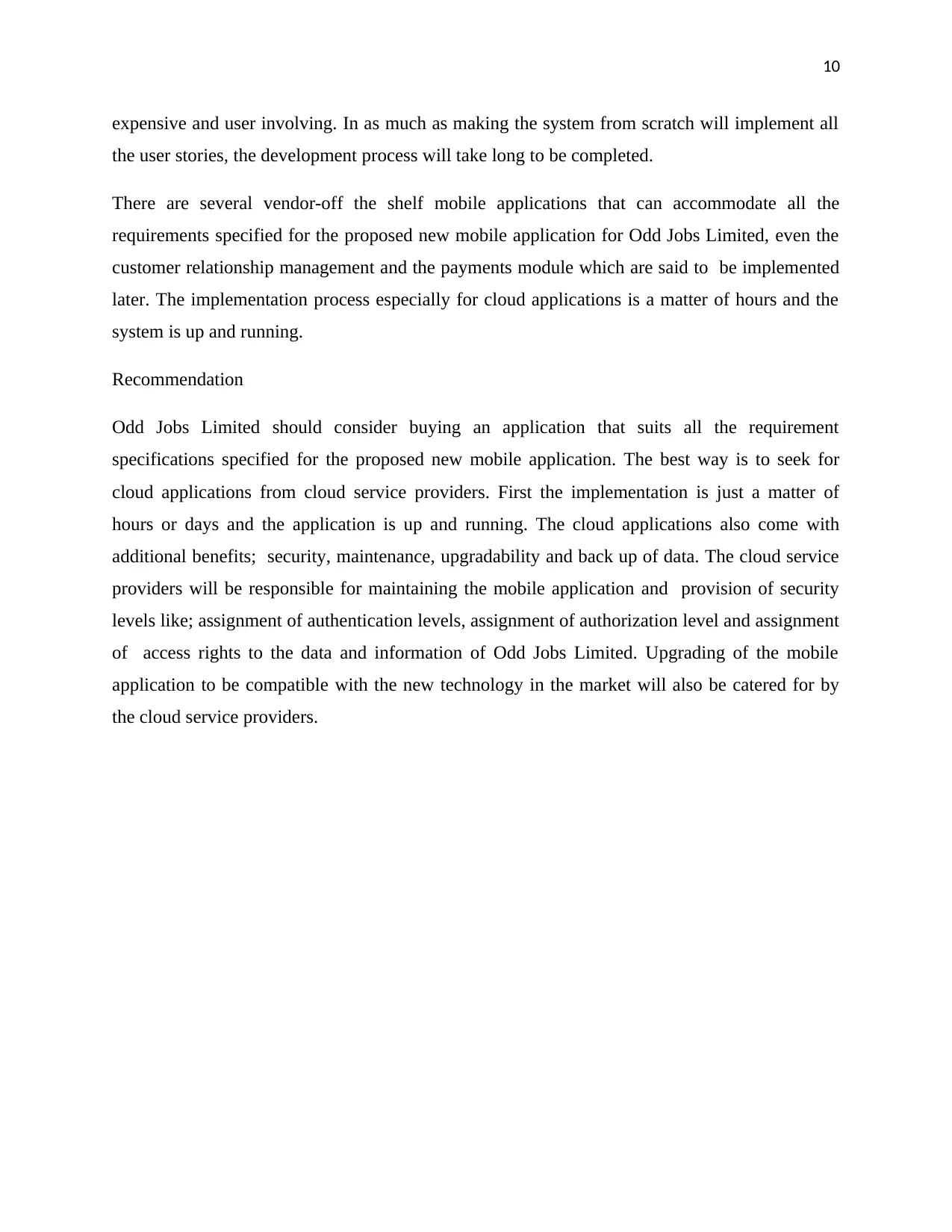
10
expensive and user involving. In as much as making the system from scratch will implement all
the user stories, the development process will take long to be completed.
There are several vendor-off the shelf mobile applications that can accommodate all the
requirements specified for the proposed new mobile application for Odd Jobs Limited, even the
customer relationship management and the payments module which are said to be implemented
later. The implementation process especially for cloud applications is a matter of hours and the
system is up and running.
Recommendation
Odd Jobs Limited should consider buying an application that suits all the requirement
specifications specified for the proposed new mobile application. The best way is to seek for
cloud applications from cloud service providers. First the implementation is just a matter of
hours or days and the application is up and running. The cloud applications also come with
additional benefits; security, maintenance, upgradability and back up of data. The cloud service
providers will be responsible for maintaining the mobile application and provision of security
levels like; assignment of authentication levels, assignment of authorization level and assignment
of access rights to the data and information of Odd Jobs Limited. Upgrading of the mobile
application to be compatible with the new technology in the market will also be catered for by
the cloud service providers.
expensive and user involving. In as much as making the system from scratch will implement all
the user stories, the development process will take long to be completed.
There are several vendor-off the shelf mobile applications that can accommodate all the
requirements specified for the proposed new mobile application for Odd Jobs Limited, even the
customer relationship management and the payments module which are said to be implemented
later. The implementation process especially for cloud applications is a matter of hours and the
system is up and running.
Recommendation
Odd Jobs Limited should consider buying an application that suits all the requirement
specifications specified for the proposed new mobile application. The best way is to seek for
cloud applications from cloud service providers. First the implementation is just a matter of
hours or days and the application is up and running. The cloud applications also come with
additional benefits; security, maintenance, upgradability and back up of data. The cloud service
providers will be responsible for maintaining the mobile application and provision of security
levels like; assignment of authentication levels, assignment of authorization level and assignment
of access rights to the data and information of Odd Jobs Limited. Upgrading of the mobile
application to be compatible with the new technology in the market will also be catered for by
the cloud service providers.
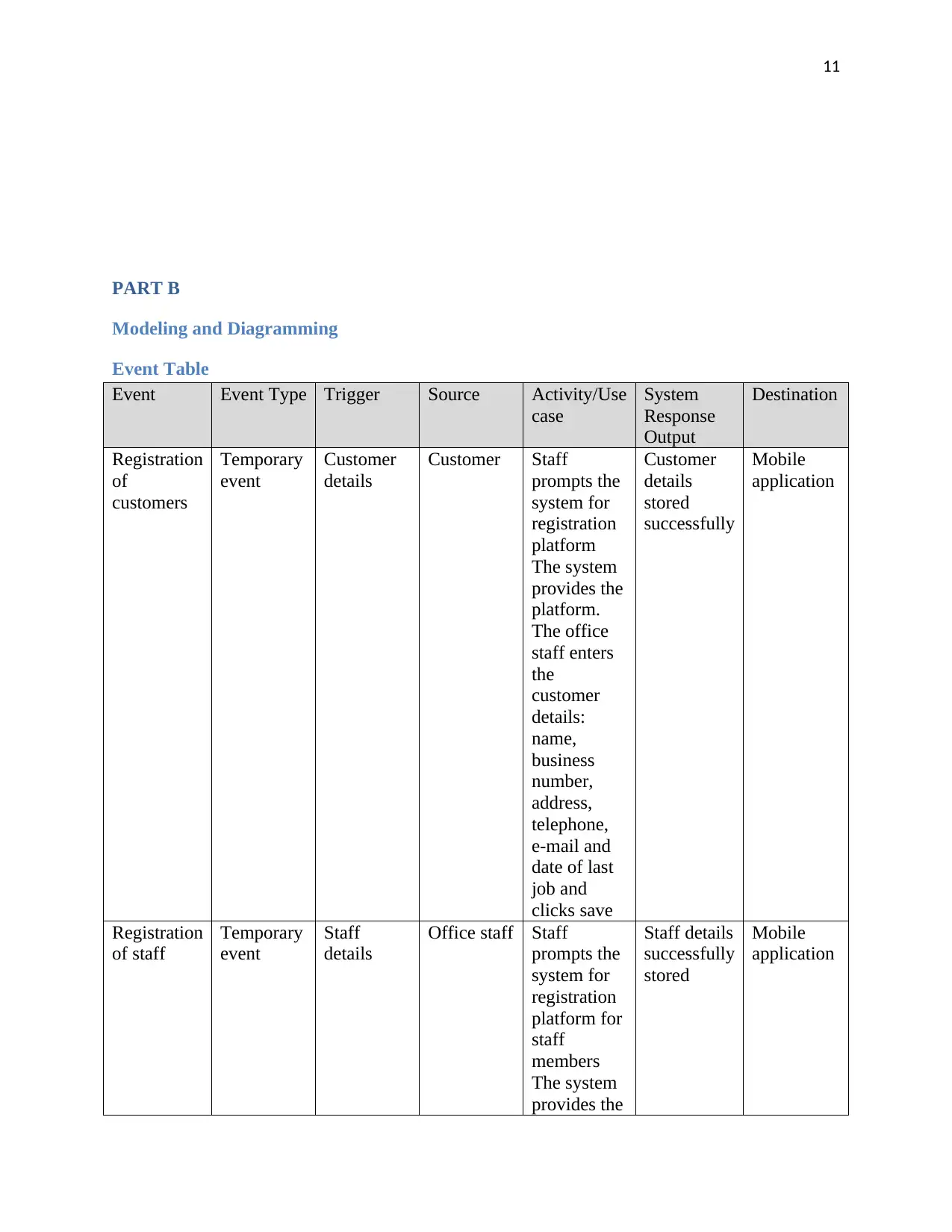
11
PART B
Modeling and Diagramming
Event Table
Event Event Type Trigger Source Activity/Use
case
System
Response
Output
Destination
Registration
of
customers
Temporary
event
Customer
details
Customer Staff
prompts the
system for
registration
platform
The system
provides the
platform.
The office
staff enters
the
customer
details:
name,
business
number,
address,
telephone,
e-mail and
date of last
job and
clicks save
Customer
details
stored
successfully
Mobile
application
Registration
of staff
Temporary
event
Staff
details
Office staff Staff
prompts the
system for
registration
platform for
staff
members
The system
provides the
Staff details
successfully
stored
Mobile
application
PART B
Modeling and Diagramming
Event Table
Event Event Type Trigger Source Activity/Use
case
System
Response
Output
Destination
Registration
of
customers
Temporary
event
Customer
details
Customer Staff
prompts the
system for
registration
platform
The system
provides the
platform.
The office
staff enters
the
customer
details:
name,
business
number,
address,
telephone,
e-mail and
date of last
job and
clicks save
Customer
details
stored
successfully
Mobile
application
Registration
of staff
Temporary
event
Staff
details
Office staff Staff
prompts the
system for
registration
platform for
staff
members
The system
provides the
Staff details
successfully
stored
Mobile
application
Paraphrase This Document
Need a fresh take? Get an instant paraphrase of this document with our AI Paraphraser
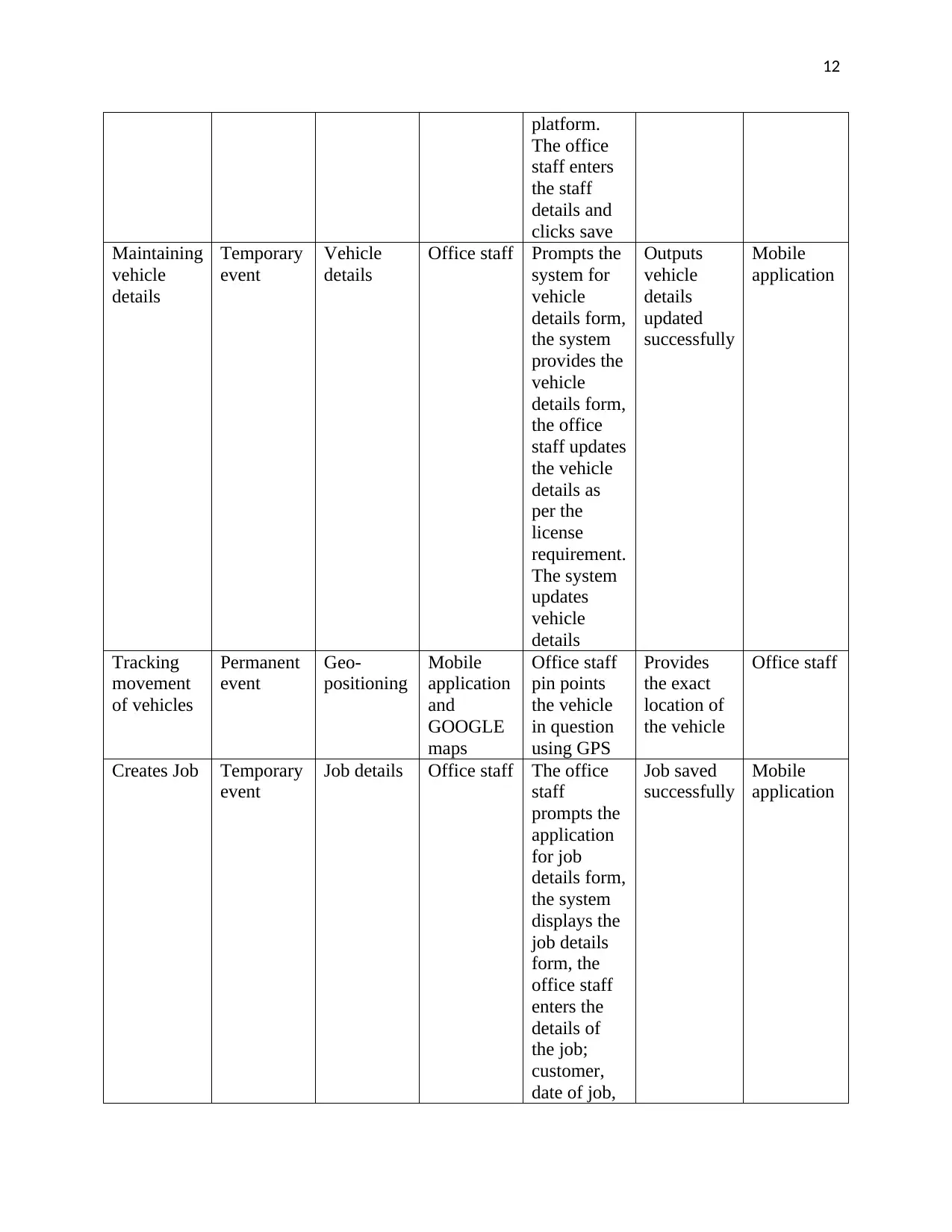
12
platform.
The office
staff enters
the staff
details and
clicks save
Maintaining
vehicle
details
Temporary
event
Vehicle
details
Office staff Prompts the
system for
vehicle
details form,
the system
provides the
vehicle
details form,
the office
staff updates
the vehicle
details as
per the
license
requirement.
The system
updates
vehicle
details
Outputs
vehicle
details
updated
successfully
Mobile
application
Tracking
movement
of vehicles
Permanent
event
Geo-
positioning
Mobile
application
and
GOOGLE
maps
Office staff
pin points
the vehicle
in question
using GPS
Provides
the exact
location of
the vehicle
Office staff
Creates Job Temporary
event
Job details Office staff The office
staff
prompts the
application
for job
details form,
the system
displays the
job details
form, the
office staff
enters the
details of
the job;
customer,
date of job,
Job saved
successfully
Mobile
application
platform.
The office
staff enters
the staff
details and
clicks save
Maintaining
vehicle
details
Temporary
event
Vehicle
details
Office staff Prompts the
system for
vehicle
details form,
the system
provides the
vehicle
details form,
the office
staff updates
the vehicle
details as
per the
license
requirement.
The system
updates
vehicle
details
Outputs
vehicle
details
updated
successfully
Mobile
application
Tracking
movement
of vehicles
Permanent
event
Geo-
positioning
Mobile
application
and
maps
Office staff
pin points
the vehicle
in question
using GPS
Provides
the exact
location of
the vehicle
Office staff
Creates Job Temporary
event
Job details Office staff The office
staff
prompts the
application
for job
details form,
the system
displays the
job details
form, the
office staff
enters the
details of
the job;
customer,
date of job,
Job saved
successfully
Mobile
application
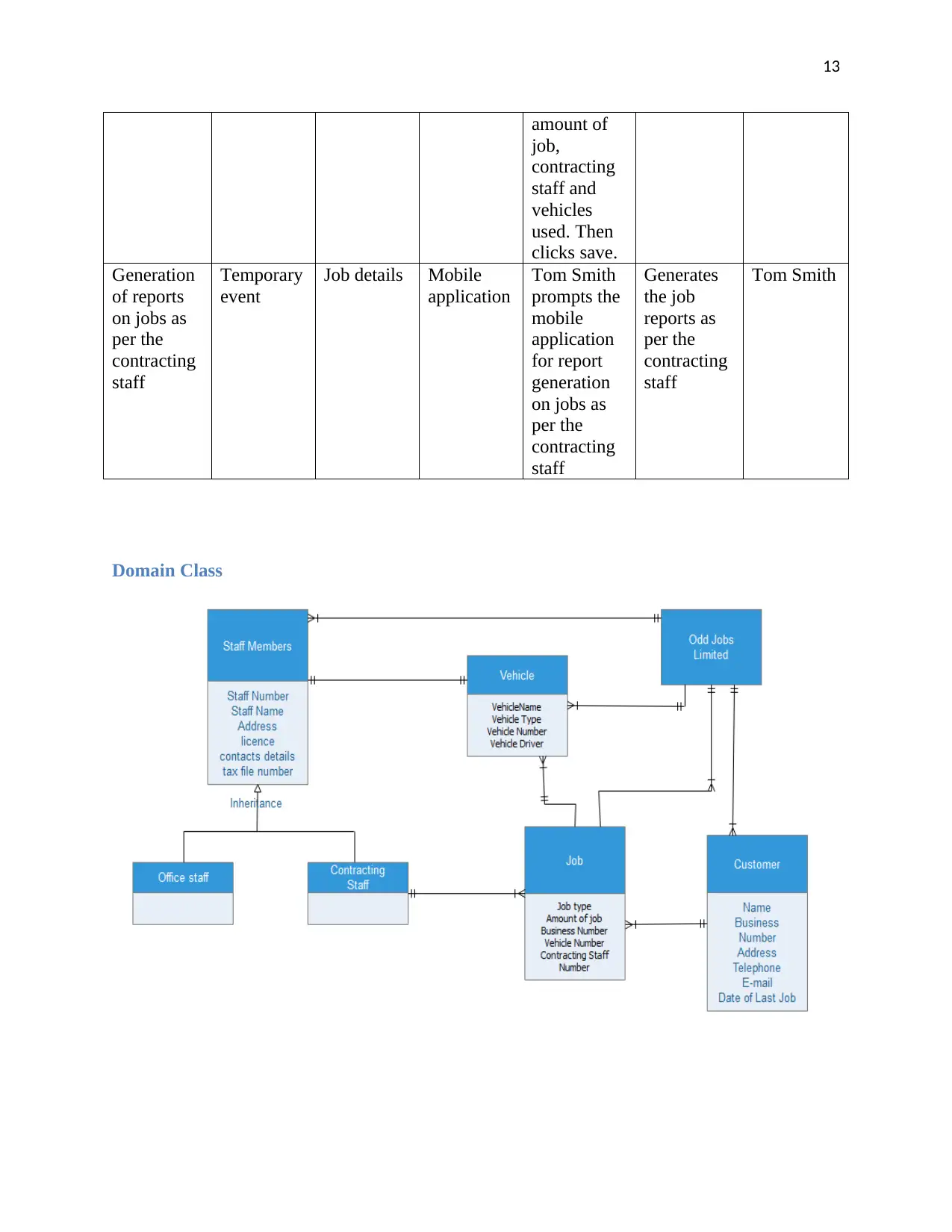
13
amount of
job,
contracting
staff and
vehicles
used. Then
clicks save.
Generation
of reports
on jobs as
per the
contracting
staff
Temporary
event
Job details Mobile
application
Tom Smith
prompts the
mobile
application
for report
generation
on jobs as
per the
contracting
staff
Generates
the job
reports as
per the
contracting
staff
Tom Smith
Domain Class
amount of
job,
contracting
staff and
vehicles
used. Then
clicks save.
Generation
of reports
on jobs as
per the
contracting
staff
Temporary
event
Job details Mobile
application
Tom Smith
prompts the
mobile
application
for report
generation
on jobs as
per the
contracting
staff
Generates
the job
reports as
per the
contracting
staff
Tom Smith
Domain Class
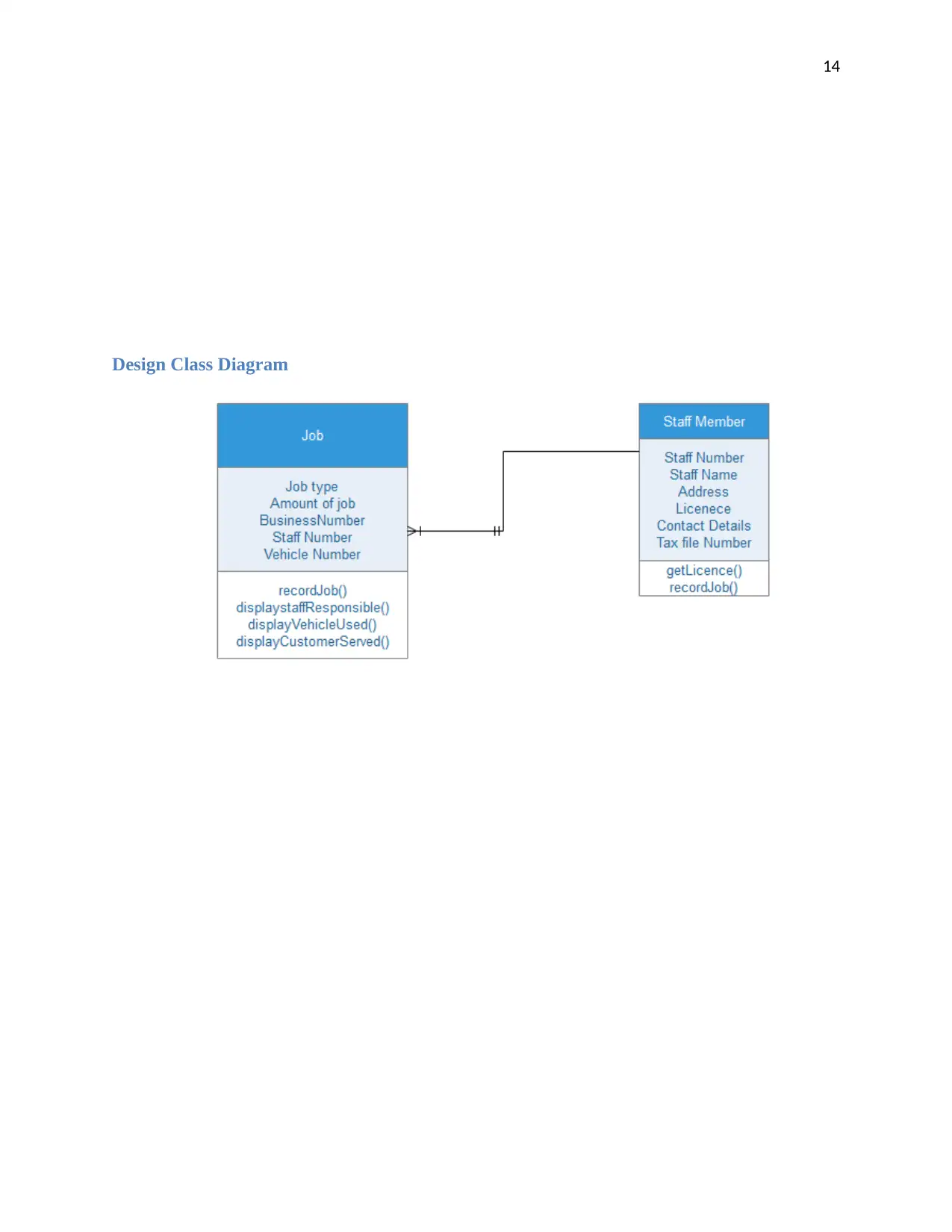
14
Design Class Diagram
Design Class Diagram
Secure Best Marks with AI Grader
Need help grading? Try our AI Grader for instant feedback on your assignments.
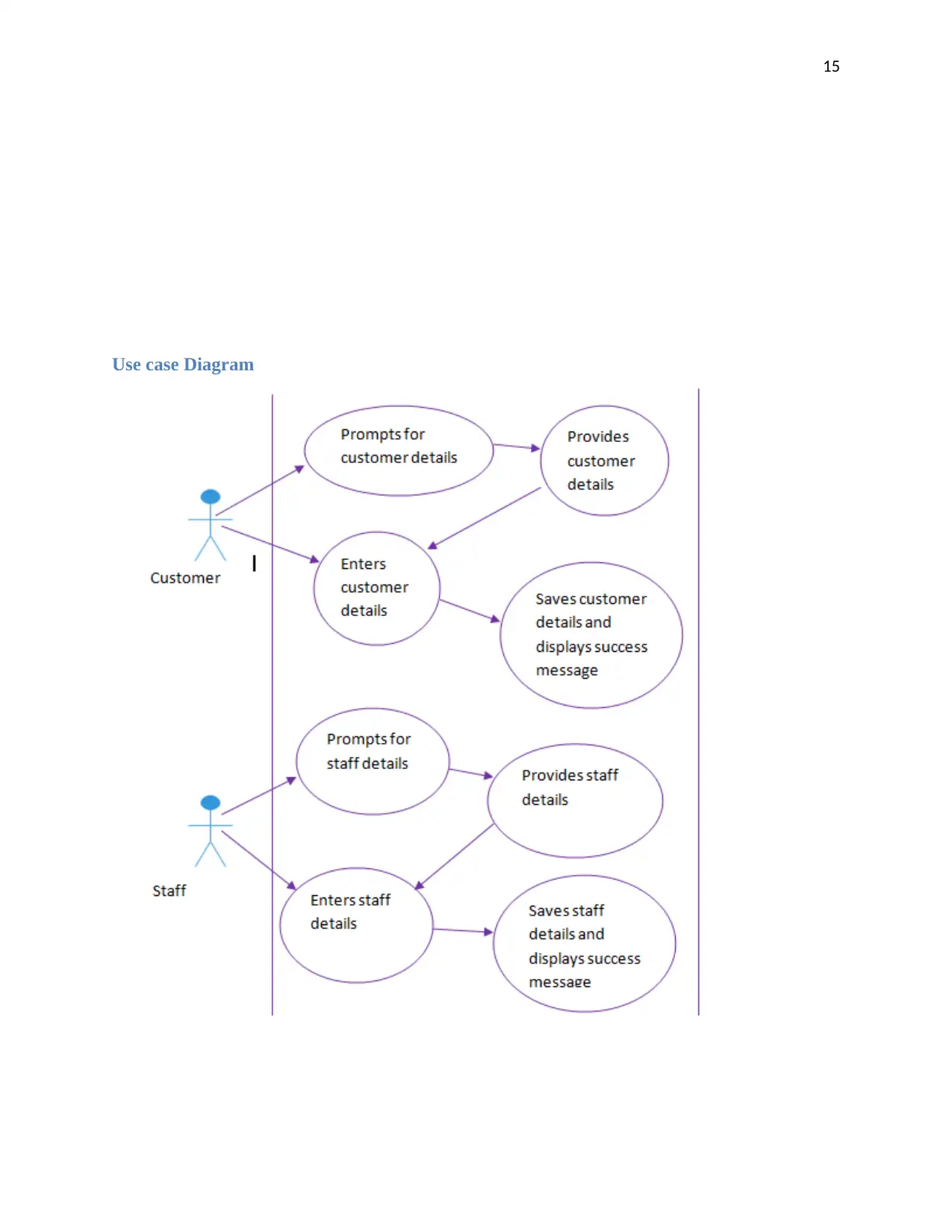
15
Use case Diagram
Use case Diagram
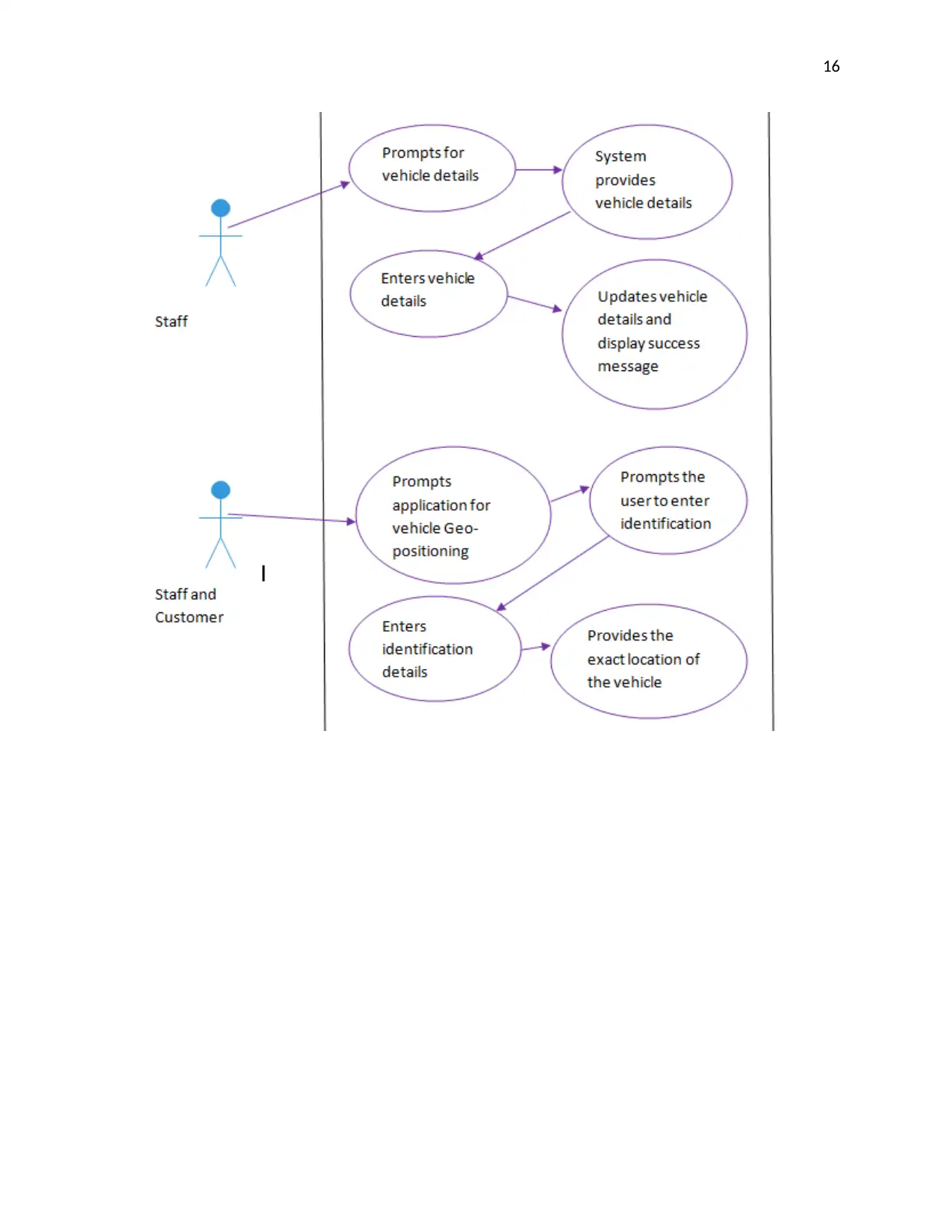
16
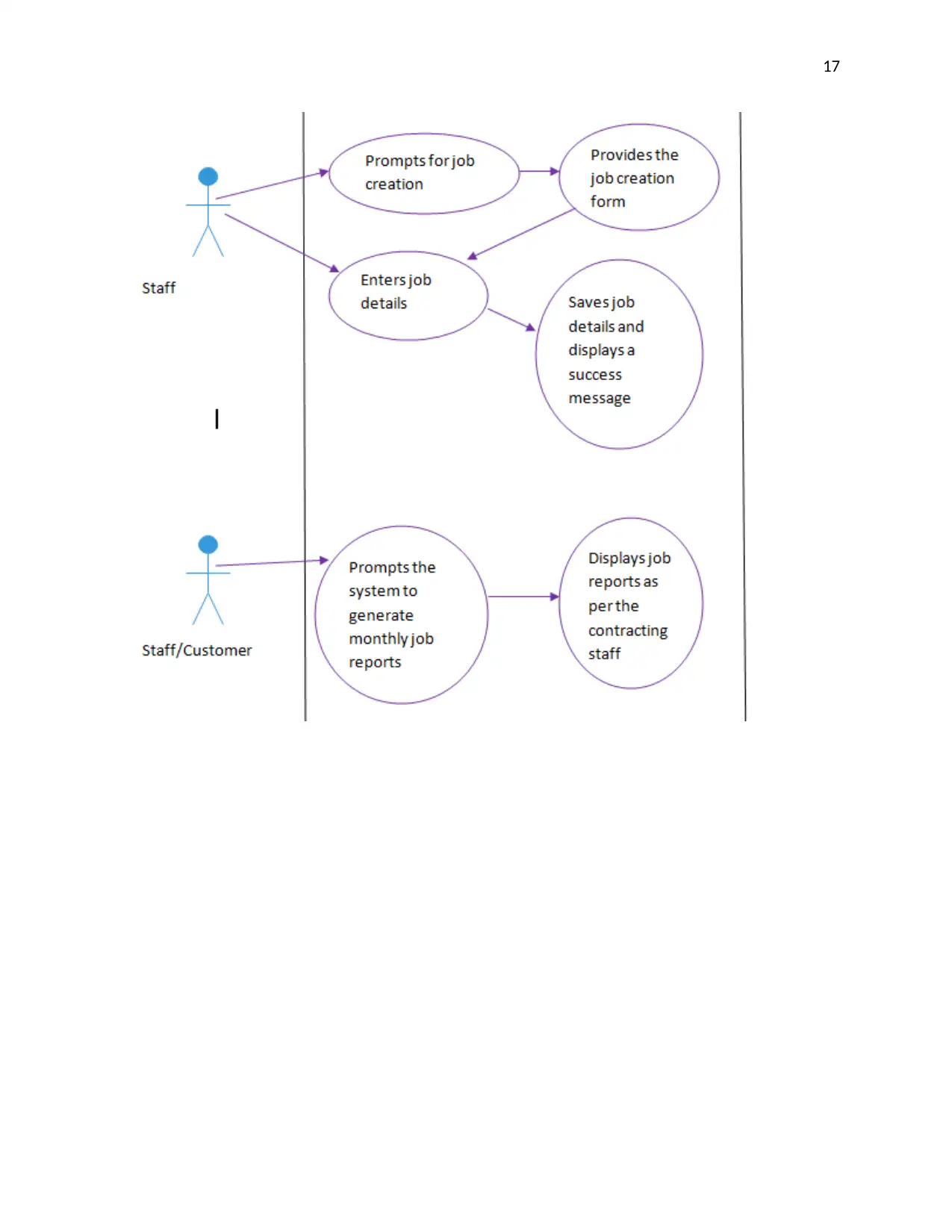
17
Paraphrase This Document
Need a fresh take? Get an instant paraphrase of this document with our AI Paraphraser
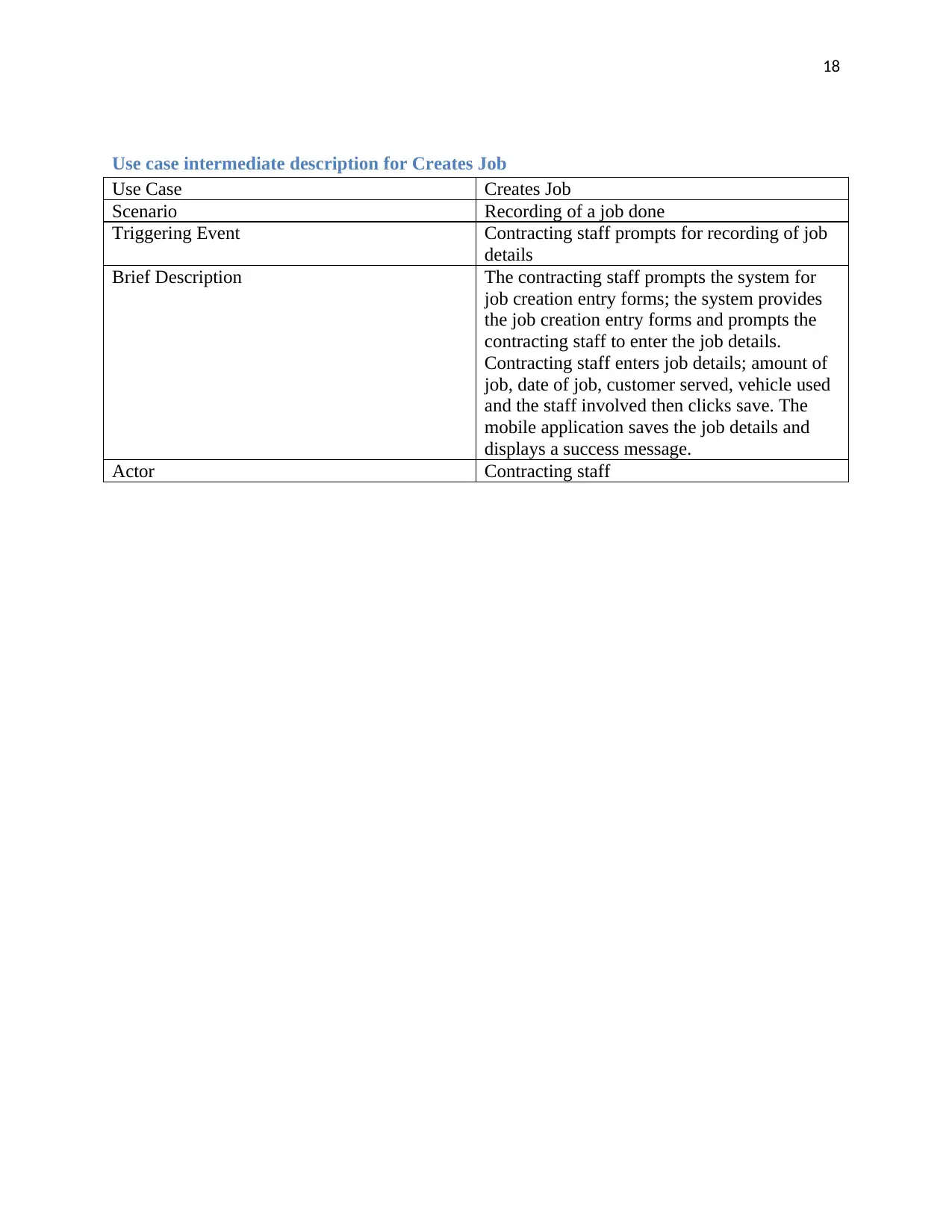
18
Use case intermediate description for Creates Job
Use Case Creates Job
Scenario Recording of a job done
Triggering Event Contracting staff prompts for recording of job
details
Brief Description The contracting staff prompts the system for
job creation entry forms; the system provides
the job creation entry forms and prompts the
contracting staff to enter the job details.
Contracting staff enters job details; amount of
job, date of job, customer served, vehicle used
and the staff involved then clicks save. The
mobile application saves the job details and
displays a success message.
Actor Contracting staff
Use case intermediate description for Creates Job
Use Case Creates Job
Scenario Recording of a job done
Triggering Event Contracting staff prompts for recording of job
details
Brief Description The contracting staff prompts the system for
job creation entry forms; the system provides
the job creation entry forms and prompts the
contracting staff to enter the job details.
Contracting staff enters job details; amount of
job, date of job, customer served, vehicle used
and the staff involved then clicks save. The
mobile application saves the job details and
displays a success message.
Actor Contracting staff
1 out of 20
Related Documents
Your All-in-One AI-Powered Toolkit for Academic Success.
+13062052269
info@desklib.com
Available 24*7 on WhatsApp / Email
![[object Object]](/_next/static/media/star-bottom.7253800d.svg)
Unlock your academic potential
© 2024 | Zucol Services PVT LTD | All rights reserved.




